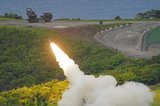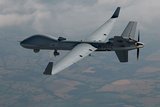Unmanned aircraft take on increased importance
The US military's expanded overseas use of unmanned aircraft highlights the increased importance of such aerial platforms to current and future military operations, senior Air Force officers said here July 23.
The Unmanned Aircraft Systems Flight Plan announced July 23 will serve as a template for how the Air Force will look in 2047 - the 100th anniversary of the US Air Force -- Gen. William M. Fraser III, the Air Force's vice chief of staff, told reporters at a Pentagon news conference.
"The future of our systems is really now," General Fraser said. "The Air Force today looks dramatically different than it did 35 years ago when I first came aboard on active duty."
The flight plan, he explained, lays out the Air Force's "vision for maximizing our efforts in unmanned aerial systems" today and in the future.
"We'll continue to push the UAS envelope," General Fraser said, adding that unmanned systems are unmanned in name only.
"While there may be no Airmen onboard the actual vehicle, there indeed are airmen involved in every step of the process," General Fraser said, including the pilots who operate the vehicles' remote controls and sensors and maintenance personnel.
Unmanned aircraft systems "represent an important addition to our comprehensive set of Air Force capabilities that actually define air power," General Fraser said.
Lt. Gen. David A. Deptula, the Air Force's deputy chief of staff for intelligence, surveillance and reconnaissance, told reporters that unmanned aircraft systems have proven effective during aerial strike missions against insurgents in Afghanistan and Pakistan, while also performing surveillance and intelligence-gathering missions.
Persistent flight capability, General Deptula said, is one of the advantages of employing unmanned aerial vehicles in military missions.
"What UASs bring to the table," General Deptula explained, "is the ability to stay in position or maneuver over large areas for a long period of time - that's where a person in an aircraft becomes a limitation."
UAS mission success rates have resulted in high demand for the unmanned aerial platforms, General Deptula said, noting that high- and medium-altitude UAS overseas combat missions have increased more than 600 percent during the past six years.
"What the Air Force wants to do," General Deptula said, "is to get the most out of these systems to increase our joint warfighting capability, while promoting service interdependency and the wisest use of our taxpayer dollars."
Yet, General Deptula said, the flight plan isn't just about how UASs are employed today, but also about how unmanned aerial technology could be applied in different mission realms in order to confront future challenges. For example, he said, UAS technology could one day be used in a modular platform that could perform a variety of tasks, such as cargo transport and aircraft refueling missions.
General Deptula equated today's level of UAS development with the progress made in manned aircraft in the 1920s.
There's "lots of potential" for expanding UAS technology across the military in the coming years, General Deptula said, but he also pointed out that replacing conventional fighter planes and pilots with unmanned aerial vehicles is a long way off.
The flight plan doesn't provide specific solutions, but it does address "concepts and possibilities that will fill in and morph over time," said Col. Eric Mathewson, the director of the Air Force's UAS Task Force.
The plan, Colonel Mathewson said, "allows us to reach out and talk to academia and industry, the other services, [Defense Department]-wide, our coalition and allied partners, and work together in a more efficient and synergistic way."
by Gerry J. Gilmore - American Forces Press Service
More from Uncrewed Vehicles
-
![What's next for the Pentagon after the Replicator programme?]()
What's next for the Pentagon after the Replicator programme?
Although the Replicator initiative has made several accomplishments, there are still multiple gaps to plug across the US Department of Defense (DoD) and its services.
-
![Cummings Aerospace showcases Hellhound loitering munition designed for US Army’s LASSO programme (video)]()
Cummings Aerospace showcases Hellhound loitering munition designed for US Army’s LASSO programme (video)
Cummings Aerospace presented its turbojet-powered Hellhound loitering munition at SOF Week 2025, offering a man-portable solution aligned with the US Army’s LASSO requirements.
-
![SOF Week 2025: PDW unveils attritable FPV drone for SOF operations at scale]()
SOF Week 2025: PDW unveils attritable FPV drone for SOF operations at scale
PDW has revealed its Attritable Multirotor First Person View drone at SOF Week 2025, offering special operations forces a low-cost, rapidly deployable platform for strike and ISR missions, inspired by battlefield lessons from Ukraine.
-
![SOF Week 2025: Teledyne FLIR white paper provides guidance on reusable loitering munitions]()
SOF Week 2025: Teledyne FLIR white paper provides guidance on reusable loitering munitions
Teledyne FLIR is highlighting the emerging requirements for 'recoverable and re-usable' loitering munitions across the contemporary operating environment during this week’s SOF Week conference in Tampa, Florida.
-
![SOF Week 2025: Kraken Technology group debuts K3 Scout USV in North America]()
SOF Week 2025: Kraken Technology group debuts K3 Scout USV in North America
High-performance maritime industry player Kraken Technology Group, based in the UK, has used the SOF Week conference in Tampa, Florida this week to debut its K3 Scout uncrewed surface vessel (USV) to the North American market.
-
![Palladyne AI and Red Cat to demonstrate capabilities for autonomous drone swarms to the US military]()
Palladyne AI and Red Cat to demonstrate capabilities for autonomous drone swarms to the US military
Red Cat and Palladyne AI recently conducted a cross-platform collaborative flight involving three diverse heterogeneous drones.

























